Abstract
Elasticity is a well-established field within mathematical physics, yet new formulations can provide deeper insight and computational advantages. This study explores the geometry of two- and three-dimensional elastic curves using the formalism of geometric algebra, offering a unified and coordinate-free approach. This work systematically derives the Frenet, Darboux, and Bishop frames within the three-dimensional geometric algebra and employs them to integrate the elastica equation. A concise Lagrangian formulation of the problem is introduced, enabling the identification of Noetherian, conserved, multi-vector moments associated with the elastic system. A particularly compact form of the elastica equation emerges when expressed in the Bishop frame, revealing structural simplifications and making the equations more amenable to analysis. Ultimately, the geometric algebra perspective uncovers a natural correspondence between the theory of free elastic curves and classical beam models, showing how constrained theories, such as Euler–Bernoulli and Kirchhoff beam formulations, arise as special cases. These results not only clarify foundational aspects of elasticity theory but also provide a framework for future applications in continuum mechanics and geometric modeling.
Keywords:
geometric algebra; Clifford algebra; Bishop frame; Frenet frame; Darboux frame; Kirchhoff beam theory MSC:
33E05; 15A66; 15A67
1. Introduction
Elasticity is a mature branch of mathematical physics. The foundations of non-linear beam models date back to Euler’s elastica, which describes planar beams undergoing bending deformations, and were later extended by Kirchhoff to spatial beams also exhibiting torsional deformations. The elastica theory is one of the oldest branches of analytical mechanics, which can be traced back to the works of the Bernoulli brothers and Leonard Euler.
The elastica theory exhibits links to other physical disciplines. For example, Hasimoto discovered special solutions including Euler’s elastica in relation to the non-linear Schrödinger equation [1]. Tsuru also found special solutions of elastic rods in three-dimensional space in relation to the local induction equation [2]. Fukumoto investigated the relations between vortex filaments and elastic rods [3]. The Euler elastica is also connected to the modified Korteweg–de Vries (mKdV) equation through the geometric evolution of curves (see, for example, [4]). In particular, when an elastica is interpreted as a planar curve whose tangent angle evolves under certain geometric flows, the angle function can satisfy the mKdV equation. This connection becomes explicit in the framework of integrable systems, where the stationary solutions of the mKdV correspond to shapes of constant elastic energy. Furthermore, the filament or vortex filament equations, when projected onto a plane or constrained to elastic curves, lead to formulations where the curvature evolves according to variants of the mKdV equation, such as the focusing or sine-modified KdV (FSMKdV) equation. Thus, the Euler elastica emerges as a natural geometric context in which the FSMKdV arises as a governing equation for the deformation of elastic curves.
The closed-form solutions for the elastica, initially derived by Saalschütz in 1880 [5], rely on the theory of Jacobi’s elliptic functions [6]. A recent account can be found in [7]. Kirchhoff discovered that the equilibrium equations for a straight, prismatic, and unstressed elastic rod are analogous to the equations for a spinning top [8,9]. These results suggest that the kinetic analogy was a useful guideline in obtaining solutions [8]. The classical approach of Love [8] adopted a Lagrangian description, characterizing a filament by contiguous cross-sections that remain undeformed, perpendicular to the rod’s center line, and capable of turning relative to each other. Under the assumptions of Love, static beam theory is equivalent to the description of an elastic curve attached to the center line of the beam, as discussed by Langer and Singer ([10], Corr. 3).
The present contribution will nevertheless offer a different perspective on the study of elastic curves in two and three spatial dimensions. The proposed approach naturally extends to higher-dimensional settings due to the dimensionally co-variant nature of the underlying formalism. As a result, the approach lends itself to a clear and nearly algorithmic generalization for use in higher-dimensional settings. This generality stems from the use of geometric algebra (GA), which provides a coordinate-free framework and enables seamless transitions between coordinate systems, guided by computational convenience.
This paper is also intended to serve as a guide for readers unfamiliar with GA. I try to persuade readers that the GA formalism is no more difficult than the more familiar vector calculus. To this end, several well-known results from the differential geometry of curves are reformulated within the GA framework, as presented in Section 3. For a broader overview of GA and its applications—particularly in physics—readers are referred to the works of Hestenes, Sobczyk [11], Doran, and Lasenby [12].
The main contribution of this paper is a coordinate-free expression of the elastica equation using only the curvature and the local inertial reference frame (i.e., Bishop’s frame) as inputs. The conserved quantities of the theory—Hamiltonian, linear, and angular momentum—are concisely derived based on the Noether theorem and second-order Lagrangian formulation. This paper is organized as follows. Section 2 introduces the main concepts of geometric algebra. Section 3 introduces the Frenet, Gradient, and Bishop frames. Section 4 develops the Euler–Lagrange theory of the elastica. Section 5 presents the main applications of the theory.
2. Geometric Algebra
While Clifford algebra affords mixed signatures, here we restrict the discussion only to algebras with positive signatures, which will be called geometric algebras, i.e., for the natural number n. The purpose of the present section is to give an extremely brief overview of the geometric algebra. Interested readers are directed to the textbook of MacDonald [13] for a more didactic overview. Clifford algebras are implemented in several Computer Algebra Systems (CAS) to facilitate symbolic and numerical computations in geometric algebra, physics, and engineering. Systems like Maple, Mathematica, and Maxima offer dedicated packages that support multi-vector operations, blade products, and grade projections. One of them has been implemented by the present author [14]. In the following we use the convention of denoting the scalars with Greek letters, the vectors with lowercase Latin letters, and multi-vectors and blades with capital Latin letters.
The planar Euclidean geometric algebra is generated by the set of orthonormal basis vectors , for which the associative, so-called geometric, product is defined with fundamental properties
The pseudoscalar is denoted by and commutes with all elements. The structure of the Euclidean algebra can be illustrated in the diagram below, which is produced by the action of the geometric product by the basis vectors.
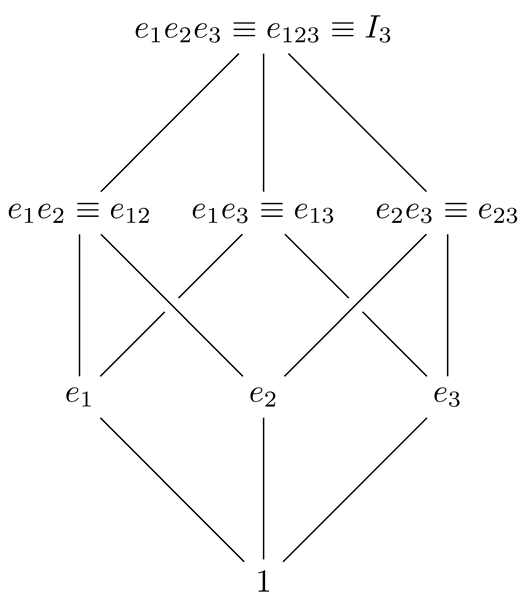
Definition 1.
The term blade will denote an ordered geometric product of basis vectors without index repetition. A blade containing k basis vectors will be called a blade of grade k. Blade composition will be denoted by index concatenation, as written in the diagram above.
From the diagram it can be read off that every row has a different grade and the upper two rows of elements are blades. Moreover, blades can be associated with geometric objects, such as planes and volumes.
A general element of the algebra is written as
and contains a scalar , vector , bi-vector , and a pseudoscalar or tri-vector part . Blades in the above expression are the bi-vectors and the pseudoscalar . Basis vectors square to 1, while blades square to −1 (see Appendix A.5). The grade extraction operation will be denoted by ⟨ ⟩k so that .
2.1. Products in GA
Besides the fundamental geometric product, the GA formalism features several other products exhibiting useful properties. The geometric product of two vectors can be decomposed into a symmetrical scalar product and an anti-symmetrical wedge product:
by the use of the polarization identity. The wedge product is also called "exterior" by some authors. Its properties are designed to match the properties of the exterior product of differential forms.
For higher-dimensional objects, the scalar product is defined simply as the scalar part of the geometric product of multi-vectors:
where the notation ⟨ ⟩k denotes the part of the multi-vector of grade k.
Furthermore, the wedge product is extended for blade a of grade k ([15], Chapter 1, p. 7) as
From this definition it is apparent that a blade can also be written as a wedge product of basis vectors as
by the orthogonality of the generators of different indices. For scalars, the exterior product is identified with re-scaling—i.e., for the scalar .
The interior product, also sometimes called Hestenes contraction (see the discussion in [16]), is an operation defined for multi-vectors as
while for scalars . Therefore, for vectors , as expected from the vector calculus. It is noteworthy also that for any vector and blade ([15], Chapter 1, p. 7), the interior product can be extended as
assuming grade k for the blade . The above formula also extends the geometric product decomposition to the products of vectors and blades:
A useful expansion formula for the vector a and blade is the sequential expansion ([15], Chapter 1, p. 7)
Another useful expansion formula for the vectors a and b and the blade is
so that the following holds for the double product: . In this way, the contraction becomes the subspace of orthogonal to a, which is one of the main applications of the contraction operation. It should be noted that unlike the scalar product the contraction is not associative in the general case.
Note that by the linearity of the so-defined products, the formulas also remain valid for generic expressions of a fixed grade k.
The familiar cross product for 3-dimensional space can be expressed as
using the pseudoscalar . Therefore, all statements for cross products can be expressed in exterior products and vice versa. The distinct types of products in GA can be used to concisely represent geometric objects and operations. Readers are directed to [13] for an introductory exposition. Multiplication tables of geometric, inner, and outer products are presented for the reader’s convenience in Appendix A.5. They are computed using the Clifford package v 2.5 in CAS Maxima [17].
2.2. Principal Automorphisms
Three principle automorphisms can be identified in geometric algebra:
- Vector reflection: ;
- Geometric product reversion: ;
- Inverse blade, or Hermite, automorphism (IBA): for the respective blade.
While the first two automorphisms are broadly recognized, the third one is less appreciated. The IBA is obviously defined only for non-nilpotent blades. Technically speaking, the reversion and IBA are anti-automorphisms [18]. For the positive signatures, i.e., in the Euclidean case, the IBA amounts to geometric product reversion .
2.3. Norm
For Clifford algebras with unspecified signatures, the norm of a multi-vector can be defined as
For vectors we have the special case , which recalls the formula for the absolute value of a scalar. For positive signatures, i.e., for , we have the equivalent formula
This allows one to define the formula for the cosine, and, respectively, the angle, between two blades A and B as
2.4. Elements of Geometric Calculus
The geometric derivative subsumes the divergence, curl, and gradient operations of the vector calculus. An introduction to the topic can be found in [19]. It is defined in the simplest way, under Einstein’s summation convention, as
where are the components of the dual or reciprocal basis, such that
for an arbitrary vector x. For the dual basis, since , where denotes Kronecker’s symbol.
The geometric derivative is co-ordinate-independent. Moreover, it splits into grade-lowering and grade-increasing parts:
Therefore, in many cases ∇ can be treated as a vector.
3. Frenet, Gradient, and Inertial Frames in 3D
In the present section, the approach outlined above will be applied to the 3D Euclidean space. Differential geometry can be readily analyzed with the tools provided by geometric algebra. The approach pioneered by Hestenes, Sobczyk, Doran, and Lasenby is to use the shape operator as the main tool for the differential geometry in geometric algebra [11], ([12], Chapter 6), [20]. It uses the tangent vectors on the surface to build the pseudoscalar at every point from the tangent vectors of the parameter curves on the surface. Although general in nature this approach is not very commonly used and can be simplified for curves and given an explicit form for engineering and physical applications.
In the subsequent discussion we work in . The pesudoscalar is denoted by and it commutes with all elements of the algebra. Consider the scalar equation , which defines a surface in 3D. We can also use it to specify a vector field-defining curve embedded in that surface in the following way.
Definition 2.
Define the curve specified by by the vector field , for which
for suitable functions , such that
holds identically.
Considering a curve in the 3D space, there is a parametrization by the length s, such that
The assumption here is that is non-singular except at .
Then define the tangent vector field as
Then obviously the radius vector can be reconstructed by curvature. Furthermore,
Therefore, the gradient is orthogonal to t, which will be used to define the gradient frame. We also obtain the equivalence
Furthermore, identically
Definition 3
(Frame bi-vector). A frame, or Darboux, bi-vector Ω is such that
for any basis vector of the mobile frame .
Except for the Frenet frame, all other frame bi-vectors will be indexed by the frame designation. Consider the identity
Therefore, we can identify an adapted frame bi-vector up to an orthogonal bi-vector B with
such that and . Different choices of B lead to different frames, as will be discussed in the next sections.
3.1. Frenet Frames
Consider the normalization constraint . Differentiate the equation to obtain
Therefore, the acceleration field is orthogonal to t. Define the curve normal vector as
where the unsigned curvature is defined as the norm of the acceleration vector
so that . The bi-normal vector b is orthogonal to the osculating plane :
without resorting to any specially constructed cross product. It also holds that
Define the torsion as
The torsion measures the amount of rotation of the Frenet frame around the tangent t as the arc length increases (see Figure 1). Differentiating orthogonality relations
yields the anti-symmetric frame coefficient matrix
The frame derivative can be computed concisely from the matrix equation
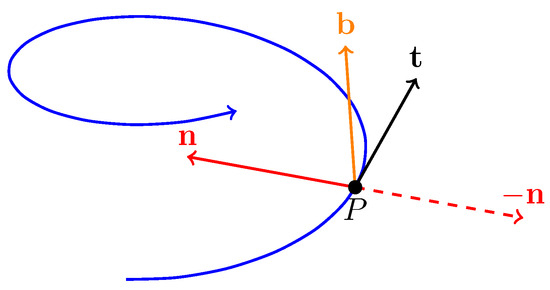
Figure 1.
Frenet frame of a curve.
The Frenet frame bi-vector can be completely specified as follows.
Proposition 1.
For the case of the Frenet frame, the Darboux or angular velocity bi-vector is
and its dual Darboux vector is
Proof.
To demonstrate the statement we first compute the inner product
Therefore,
Compute
□
Therefore, the trajectory can be recovered by quadrature starting from the integral
so that
Remark 1.
The analogy between the frame matrix and frame bi-vector is not complete. The frame matrix Ω is singular since . This is not the case for the frame bi-vector Ω, since the product results in a scalar, which is also the determinant of the bi-vector, so that its inverse is
3.2. Gradient (Darboux) Frame
Define the surface normal vector as
Remark 2.
The above relationship defines the Gauss map of the surface :
Define the osculating plane by the bi-vector and the tangent plane by . Define the bi-normal vector b to be orthogonal to the osculating plane O:
Then . It also holds that
as before. Differentiating the orthogonality relations
yields the anti-symmetric coefficient frame matrix as before.
We will look for a Darboux bi-vector as before starting from the identity
Then
such that so that holds. Consider the constraint equation
Therefore
Proposition 2.
For the case of the gradient frame, the Darboux, or angular velocity, bi-vector, is
Proof.
Consider the bi-vector specified in Equation (24). Compute
in terms of the dual vector. Therefore,
Furthermore,
Therefore, the Darboux vector is
Therefore,
However,
Therefore,
Therefore, is the Darboux bi-vector of the gradient frame. □
Define the coefficients
To determine explicitly and , we use the following approach. Define the unit vector (i.e., the Frenet normal)
Then also . On the other hand,
Therefore, and b are co-linear. Moreover, since both are unit vectors it follows that . Therefore, . Therefore, there are two possible combinations, and . Considering the planar case we observe that the second option is realized. Therefore, .
To obtain the transformation matrix between the Frenet and gradient frames, we proceed as follows. Define the dual vector
Then
Therefore, n and are co-linear. Furthermore,
Therefore, and . Therefore,
To summarize, the Frenet and gradient frames are related by the transformation
or in shortened matrix notation
From the above equation it is apparent that is an orthogonal matrix—.
The two frame matrices are related by
The frame matrix is
Remark 3.
The name Darboux frame is justified since we can identify the plane as the surface “arena” where the equations evolve. Since the Darboux frame is represented by the matrix
Then for the plane ; so up to the orientation of the normal vector one can identify with .
The tangent field can be recovered by quadrature as
The gradient frame can be recognized as the Darboux frame for the plane, where the geodesic curvature .
Remark 4.
The gradient frame can be suitable for immersed elastic curves and also in the case where one wishes to characterize the interaction of the elastica with the medium. There, one could specify a normal forcing field as a constraint of the equations. Therefore, by duality, in a deformed body (under a strain field) the strength of interaction can be given by the value of .
3.3. Bishop (Inertial) Frames
The Bishop, or parallel transport, frame [21] is an alternative description that is well-defined even when the curve has vanishing acceleration. The Bishop frame is such that
and, furthermore, the frame matrix has the form
To connect with the approach discussed so far, we observe that for the first row the following holds:
Therefore, one can posit the rotation relationship
for some phase function of the arc length to be determined further.
Therefore, the frame matrix becomes
To construct the frame we proceed as follows. Take the dot product with b
Therefore, up to sign (i.e., a reflection)
On the other hand, taking the dot product with n results in
Therefore,
Therefore, the coordinate transformation can be identified with a rotation in the normal plane, or in matrix notation:
A direct computation shows that the Bishop frame is related to the Frenet frame as
which can be identified with a reflection at an angle . In shortened matrix notation
The Bishop frame matrix is related to the Frenet frame’s matrix as
which can be demonstrated by a short computation by differentiating Equation (37).
We look for a Darboux bi-vector of the form
Then
Furthermore
and finally
by hypothesis. Therefore, we can conclude that and the Darboux bi-vector has the especially simple form ([11], Chapter 6, p. 238)
To determine the function we proceed as follows. Using the Frenet frame we form the invariant volume
Observe that
Then under the orientation convention we have
Therefore, from Equation (40) it follows that
as also determined in [10]. In other words, is the integral or cumulative torsion up to orientation of the pseudoscalar. It is a multiple of the twisting number. From this presentation it is apparent that geometric algebra streamlines calculations.
3.4. Summary of the Frame Expressions
The above results can be summarized in the following Table 1.

Table 1.
Summary of the frame expressions.
4. Euler–Lagrange Formulation of the Elastica Problem
A beam is defined to be a three-dimensional deformable body whose length is much larger than its other two dimensions. Such a body can be described by a curve threading its center line in and a cross-section at every point of the curve whose intersection is precisely the barycenter of the section. Variational analysis has been presented for the Kirchhoff rod in [10].
4.1. Free Elastica Equations
The elastica theory is the oldest variational model of elastic rods. The core of the presented approach is coordinate-free. The constrained Lagrangian energy density functional is identified as
where its independent variables are vectors and the multiplier is scalar, while t is not assumed a priori to be the tangent field. This Lagrangian is of first order in the variable t. However, if evaluated on the tangent field it becomes of second order in the radius vector field. Moreover, in this case it becomes manifestly translationally invariant. The above Lagrangian corresponds to the traditional definition given in [10,22] since
where is the curvature as defined above since t is taken to be the tangent vector field.
Remark 5.
In principle, anisotropy can be incorporated by modifying the scalar product to a symmetric positive-defined bi-linear form A
Since such a matrix can be put into a diagonal form, this would result in shear and scaling deformations compared to the homogeneous configuration.
Furthermore, assume that , . The tangent field and its derivative are varied independently. To enact the variations we use the generalized partial gradient operator:
The free elastica equation can be derived as follows. Observe the relations
Therefore, the Euler–Lagrange equations in the variables are
That is, it holds that
4.2. Symmetries of the Lagrangian
The first equation integrates to the constant vector field J, which is also a Noether current, such that
up to sign. Furthermore, define the pseudoscalar
and differentiate it to obtain
using the equation of motion. Therefore, w is also constant. Denote its magnitude by . Observe that it is an invariant that does not depend on the used basis.
Furthermore, we establish the stronger result that
without explicitly using the dimensionality of Euclidean space. Therefore, we claim
Proposition 3.
An elastica is confined to a 3-dimensional subspace of .
Therefore, without loss of generality we assume further that so that we can use the approach developed in Section 3.
The Lagrangian is manifestly translationally and rotationally invariant, which assures the existence of Noether currents, as fully elaborated in Appendix A.6. As indicated above, depends on the second derivative of the radius vector field . Therefore, by the Ostrogradsky principle for higher-order Lagrangians [23], the equation for the Hamiltonian, denoted by , is given by
where we have defined the extended canonical momentum as
and observed that . Differentiate the Hamiltonian and use the equations of motion to obtain
by the orthogonality of t and . Therefore, it was just established that the Hamiltonian is a first integral of the system—i.e., a constant when evaluated on the solution curve.
Furthermore, the conservation of the Hamiltonian can be interpreted as the energy conservation law for the elastic energy density:
applying the normalization of t and the definition of . Since the Hamiltonian is conserved, we use the Roman letter H to indicate its value on the solution curve.
Remark 6.
It is known that higher-derivatives Lagrangians lead to unbounded Hamiltonians and may lead to so-called Ostrogradsky instabilities. Ostrogradsky instability remains a central and actively studied issue in the context of higher-derivative theories. A recent application can be found in [24].
Observe that is an affine function of the generalized momentum and may exhibit such an instability. Here the Ostrogradsky instability is avoided by virtue of the constant linear momentum , which links the tangent vector field to its second derivative. On the solution curve the Hamiltonian is constant, . Since is assumed to exist almost everywhere in the configuration space, there is a number K, such that . Therefore,
where we denote . Further elaboration of the Hamiltonian formalism for the elastica problem is beyond the scope of the present paper but can be developed as outlined in [23].
The angular momentum can be identified with the bi-vector (see Appendix A.6)
relating naturally to the Bishop frame bi-vector. Therefore,
is the expression of the conservation law of angular momentum. Therefore, can be identified with some constant M—i.e., . In an initial value setting, we also have .
One can summarize the above results in the following statement.
Proposition 4.
The free elastica system has two conserved momenta—the linear one J, given by Equation (45) and the angular one
as well as conserved energy
Remark 7.
In order to account for distributed loads, the Lagrangian can be equipped with a scalar potential term . In such a case, the Euler–Lagrange equations read
Projecting the linear momentum J onto the tangent field results in a total derivative
since V is a scalar. The Hamiltonian is
as before. Then
so that the Hamiltonian is conserved as before. The angular momentum can be identified as before as
Then
However, since V is a scalar the last term vanishes and the angular momentum is conserved, as before.
Remark 8.
We can define the generalized, multi-vector Hamiltonian, which combines both conservation laws, as an even element of the algebra as
In this formulation, corresponds to a constant quaternion. Therefore, we have just established that an elastica can be suitably parametrizied, and therefore classified, by a quaternion up to a rigid motion.
Observe that
up to sign and is also constant. Note that up to the last equation the approach is completely frame-independent. Thus, the choice of a specific frame and coordinates is a matter of utility guided by the need to simplify computations.
4.3. Derivation of the Curvature Equation Using the Frenet Frame
Observe that
Furthermore, compute the pseudoscalar and identify the constraint
coupling curvature and torsion.
Having derived the relevant symmetries of the system at this point, we specialize the discussion and employ Frenet frames to evaluate J.
Therefore,
in the Frenet frame. The magnitude of the momentum vector can be calculated from the scalar product
for some constant j giving the norm of J. Observe that the above equation is also frame-independent.
Lastly, the Lagrange multiplier’s functional form is determined in the following way. Project J onto the tangent vector to obtain
Substitute in Equation (51) to obtain the Lagrange multiplier
Project J onto the normal vector to obtain
Differentiate to obtain
Substitute from Equation (56) to obtain
agreeing with the result in [25].
Remark 9.
The traditional derivation of the elastic equation proceeds as follows [26]. Differentiate J and use the Frenet frame equations
to obtain a system of three constraints:
Solve the constraint for the torsion
and the Lagrange multiplier
Substitute the solutions into the remaining constraint. Observe that using the traditional approach the role of the constants H and c is not apparent and one has to solve two ODEs to obtain the sought relationship.
The advantage of the geometric algebraic approach is that one does not need to solve a differential equation for the torsion. Instead, the role of the invariant pseudoscalar is emphasized. From the present discussion it transpires that the choice of frame is a matter of convenience for the problem at hand.
The preceding discussion can be formulated concisely in the following theorem.
Theorem 1.
The 3-dimensional elastica system is equivalent to the first-order ODE
which can be differentiated into the second-order differential equation
where H is the constant Hamiltonian energy density of the system, c is the torsion coupling, and j is the magnitude of the generalized momentum J. The vector field J can be expressed in the Frenet frame as
4.4. Classification of Elastic Curves Using Geometric Invariants
The geometrical meaning of the torsion coupling condition requires some attention. In the first place,
Also . Therefore,
or equivalently,
in terms of the volume invariant. Therefore, in the non-trivial case, linear dependence between the three vectors () implies that the curve is planar (i.e., ). Let . Obviously, whenever t and are linearly dependent, . On the other hand, suppose that only . Then
Meanwhile
Furthermore, is in the span of () since . The above results can be neatly summarized in the following diagram:
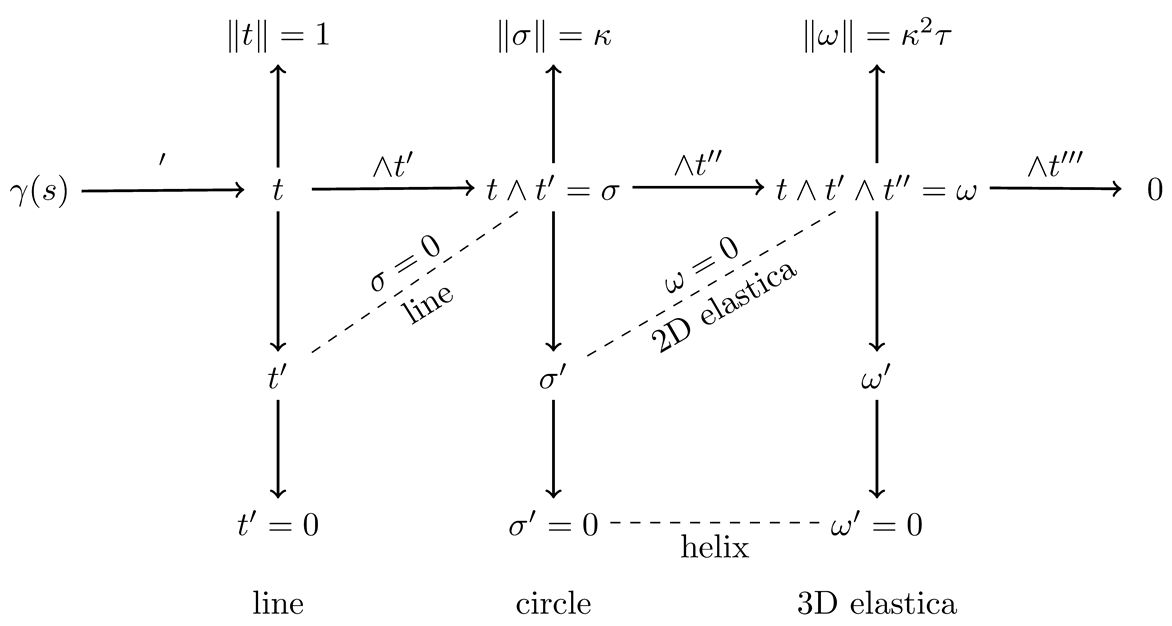
The above diagram is generated by the consecutive action of two operators—covariant arc length differentiation and exterior multiplication. The top row of the diagram summarizes the geometric invariants, which are the norms of the geometric objects, i.e., vectors, surfaces, and volumes, constructed by the covariant derivatives of the radius vector field in the middle row. The bottom row represents the limiting cases where the covariant derivatives of the respective objects vanish.
5. Applications
As already demonstrated, the elastica is confined to a subspace of of maximal dimension 3. Therefore, there are only two non-trivial cases—a planar elastica and a 3D elastica.
5.1. Planar Elastica
In this section we assume that the elastica is confined to a plane. Then . The curvature differential equation becomes
The equation is resolved by variation of parameters using the generic ansatz
using the Jacobi delta amplitudinis function. In the formula A can be interpreted as a bending, q as a stretching, and m as a shape parameter. Some properties of the Jacobi functions and the associated elliptic integrals necessary for the present discussion are surveyed in Appendix A. This leads to the algebraic system for the undetermined parameters A, q, and m:
The non-trivial solutions of the system are given by the set
Observe that . Only the solutions with positive curvature are geometrically admissible, that is where A is positive. This leads to a general solution of the form
since . Therefore, , fixing the interpretation of the parameter. The case corresponds to a circle since in this case and the curvature is constant. Therefore, one is left with the following two non-trivial cases:
The second set corresponds to . Therefore, we restrict the first set to .
This corresponds to the results given in [27] after a suitable reparametrization.
Furthermore, m is constrained by j since
Therefore, the shape of the elastica is determined by two factors—the initial value of the curvature and the magnitude of the linear momentum j.
The energy of the elastica is
Observe that corresponds to vanishing energy—.
5.2. Generic 3D Elastica
We follow the method described in [26], where the proposition stated below is proven.
Proposition 5.
The substitution results in an autonomous ODE for u:
Proof.
Suppose that . Observe that wherever
Therefore,
and multiplying by u yields
□
This equation can be integrated in elliptic functions as follows [10,25,28,29]. We make the ansatz
for the parameters p, A, m, and q, which are to be determined further.
Observe that the 2D case corresponds to . Using some identities for the elliptic functions, one arrives at the following system of polynomial equations for the parameters:
Therefore, a non-trivial constraint is . This leads to a parametric solution of the form
and furthermore
fixing the interpretation of p. The case as before leads to a circle since . Therefore, we can further assume .
Equation (73) contains only the integration constants H, c, and j besides the parameter p. Therefore, the solutions can be parameterized by the roots of the equation for p. Then
and
In another parametrization, eliminating A, we have the system of equations
which couples the p an q parameters algebraically. The advantage here is the linear relationship between p and H. The positive solution for q is
The denominator is always positive. Then the solutions are parametrized by the value of m. In the 2D case, as observed
Otherwise,
and
Remark 10.
The torsion is
which determines the Frenet frame. This can be integrated into an incomplete elliptical integral of the third kind:
allowing for calculation of the Bishop frame.
Example 1.
As an example consider a circular helix. Take the values of and as inputs. Consider a concrete implementation
Then the task is to determine the parameters a and g from the inputs. One proceeds as follows. Compute
so that
and
The Bishop frame is easily computed as
and it is dual to the binormal
Furthermore, one can directly compute
According to Theorem 1 we have
and
so that . Then one can compute the conserved momenta and energy
One can also identify
which completes the parametrization.
5.3. Integration of the Elastica in Terms of the Bishop Frame
Observe that Equation (48) can be integrated as
Adding both conservation laws allows one to solve for the field using the invertibility of the geometric product:
Observe that the above formulation is coordinate-free, demonstrating the advantage of the geometric algebra approach. Therefore, we establish that the elastica is a completely integrable system in terms of the Bishop frame.
The conserved momentum allows for aligning the solution to a global basis and identifying a preferred coordinate system. Such a convenient system is the cylindrical one [25,28], aligned with the momentum J (see Figure 2). We define the constant-altitude unit vector along the direction of J as
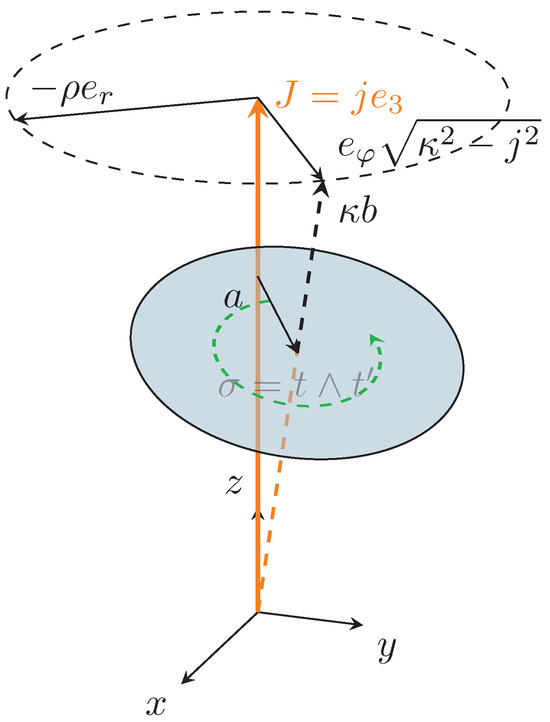
Figure 2.
The preferred coordination system and Bishop frame configuration.
In summary, we can formulate following result.
Theorem 2.
Suppose that , J, H, and M are specified. Then the elastica curve can be reconstructed by quadrature as follows:
under the compatibility condition
Proof.
Consider the identity (Equation (49)). Therefore, we are led to a new equation in terms of the preferred direction, which splits into translational and rotational components as follows:
Furthermore, the first term can be interpreted as a sum of translations while the second term as a sum of rotations.
Equation (88) implies the compatibility condition
Therefore, formally the Bishop frame can be determined by quadrature as
from the tangent field, so the total angular momentum can be identified with the integration constant of the Bishop frame. □
Geometrically Equation (90) amounts to establishing a preferred orientation of the system (i.e., a global cylindrical symmetry). Using these coordinates, the solutions can be represented conveniently in a cylindrical coordinate system [28]. Then for the altitude we have
So we can identify the altitude (i.e., the z-axis) with the direction of translation. Using Equation (74) one obtains directly
in terms of the Jacobi epsilon function.
Consider the identity
We can solve for the radial component as
and furthermore,
To obtain the angular coordinate proceed as follows. Differentiate Equation (92) as
Take the inner products
Integrate to obtain the polar coordinates
The procedure is explicated in the next section.
5.4. Construction of the Preferred Coordinate System
The exposition follows the approach of [28], taking into account the differences in the employed formalism. Observe that so that (see Figure 2). The solid angle subtended between the planes and is given by
To construct compute the rejection vector for b in the plane (see Figure 3)
Furthermore, we have the identity
Therefore, the norm of the vector a can be computed as
after substituting in Equation (54) since .
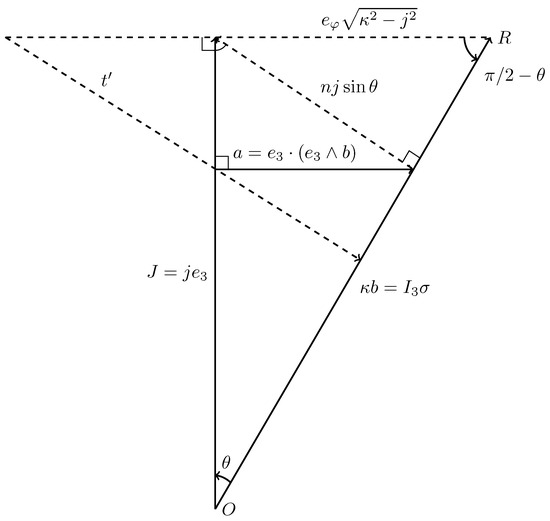
Figure 3.
A section of the preferred coordination system with the Bishop frame.
Observe that in cylindrical coordinates
The two remaining coordinate equations can be obtained as the scalar products
Direct representation of a in terms of the Frenet frame using Equation (60) results in
Furthermore, the third basis vector can be computed as .
Then
so that
Therefore,
from Equations (95) and (98), which directly integrates to
Furthermore,
so that
This can be integrated into
in terms of the incomplete elliptic integral of the third kind, corresponding to the result in [28]. This is, however, not the most convenient representation, as noted in [29]. It is produced here only to demonstrate the correspondence of the approach.
5.5. Specialization to 2D
To connect with the planar elastica, we use the frames {} with the pseudoscalar . Observe that the Bishop frame is simply and the angular momentum bi-vector is and . We can fix the origin of the curve at (0, 0); then . Then one immediately obtains the solution
and . From the parametric system m is constrained as and . The tangential field becomes
Furthermore, the linear momentum becomes
which is constant, in agreement with the theory.
Example 2.
The solution for is the curve given by
Example 3.
The solution for is the curve given by
Note that in this case the analytical continuation identities must be used for computation.
6. Discussion
The present contribution considers the problem of 2D and 3D non-extendable elastic beams and rods from the perspective of geometric algebra. This allows for a great simplification of the problem due to the considerable expression power of the geometric algebra approach. Notably, the approach obviates the use of a non-Euclidean configuration space [9]. Instead, all calculations are performed in the physical Euclidean space.
Possible applications of the approach are inverse problems, image segmentation, Finite Element Modeling, FEM, or the Boundary Element Method, BEM. For example, Liu and Hong [30] and later Grigoriev and Yakovlev [31] explored applications of GA to elasticity. Liu and Hong constructed multiple-component spatial harmonic functions and developed a GA-valued BEM in order to solve numerically three-dimensional problems of elasticity for an arbitrary domain with complicated boundary conditions. Klimek et al. [32] achieve discretization of Maxwell’s equations for non-inertial observers using Space-Time Algebra. The main application that was demonstrated was the manifestation of Sagnac’s effect in a rotating ring resonator.
This paper demonstrates the forms of Frenet, Darboux, and Bishop frames in . Furthermore it offers a new Lagrangian formulation of the elastica theory. This allows for construction of the fundamental Notherian conserved quantities—energy and linear and angular momentum. The geometric algebra approach also enables an intuitive classification of the elastica system using its geometric invariants. Concise expressions of the elastica equations are found using the Bishop frame. The geometric algebra approach demonstrates natural correspondence of the free elastic problem with Kirchhoff beam theory. Finally, we have determined a new coordinate-free formulation of the solution (Theorem 2).
Funding
The present work was funded by the European Union’s Horizon Europe program under grant agreement VIBraTE 101086815.
Data Availability Statement
The original contributions presented in this study are included in the article. Further inquiries can be directed to the author.
Acknowledgments
This paper is dedicated to the memory of my father Petko Prodanov.
Conflicts of Interest
The author declares no conflicts of interest. The funders had no role in the design of the study; in the collection, analyses, or interpretation of data; in the writing of the manuscript; or in the decision to publish the results.
Abbreviations
The following abbreviations are used in this manuscript:
| BEM | Boundary Element Method |
| FEM | Finite Element Modeling |
| GA | Geometric Algebra |
| IBA | Inverse Blade Automorphism |
| ODE | Ordinary Differential Equation |
Appendix A. Elliptic Integrals and Functions
Originally emerging from formulas for arc lengths of ellipses, elliptic integrals are defined as integrals involving square roots of polynomials of degree three or four, and they cannot be expressed in terms of elementary functions. Their inverses give rise to elliptic functions—doubly periodic meromorphic functions that generalize the trigonometric functions on the ellipse. Readers are directed to the classical works of Greenhill [6] and Byrd and Friedman [6] for more details.
Appendix A.1. Elliptic Integrals of the First Kind
The following is an incomplete elliptic integral of the first kind:
where is the parameter. For the integral is analytically continued in the complex plane. The complete elliptic integral is defined as
The Jacobi amplitude function is the inverse of the integral:
for all admissible values of m. The amplitude can be smoothly continued as
Its derivative is denoted by :
The notation comes from the name delta amplitudinis.
The elliptic sine and cosine are defined by
Therefore, we have the identity
Furthermore,
Therefore, we have the identity
Appendix A.2. Elliptic Integrals of the Second Kind
An incomplete elliptic integral of the second kind is defined as follows:
for . For the integral is analytically continued in the complex plane. The complete elliptic integral is defined as .
The Jacobi epsilon function is defined as
The epsilon function is related to the incomplete elliptic integral of the second kind as
Appendix A.3. Elliptic Integrals of the Third Kind
The incomplete elliptic integral of the third kind is given by
Furthermore, the integral can be analytically continued to a quasi-periodic function as
where denotes the fractional part of modulo . The integral is related to the elliptic functions by the integral equation
This formula follows from the substitution so that in the original argument. Therefore, we can also define the formula
The complete elliptic integral of the third kind is given by
Appendix A.4. Integral Identities
The following identities hold true:
Appendix A.5. Inner and Outer Products in
Multiplication table of the geometric product:
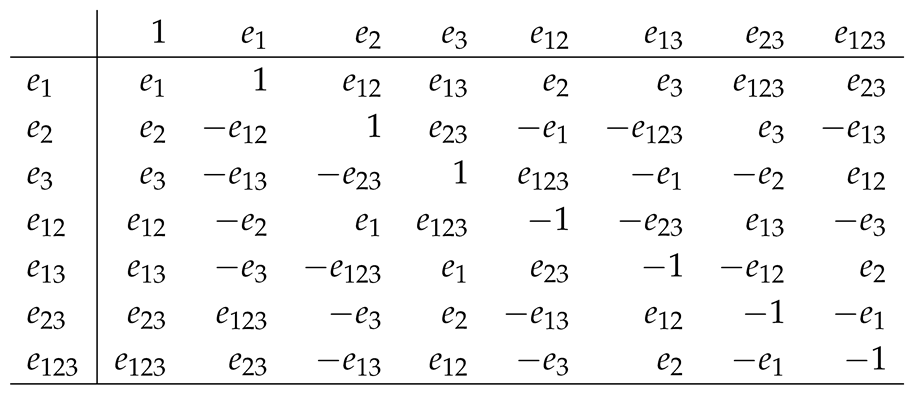
Multiplication table of the symmetric inner product (i.e., Hestenes contraction):
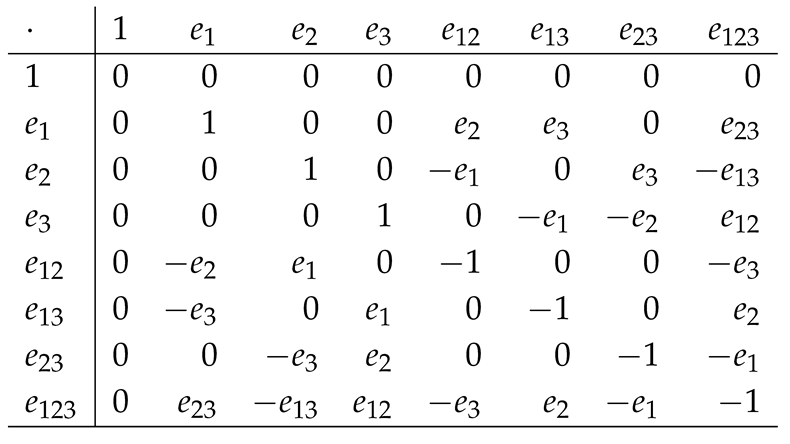
Multiplication table of the anti-symmetric outer product:
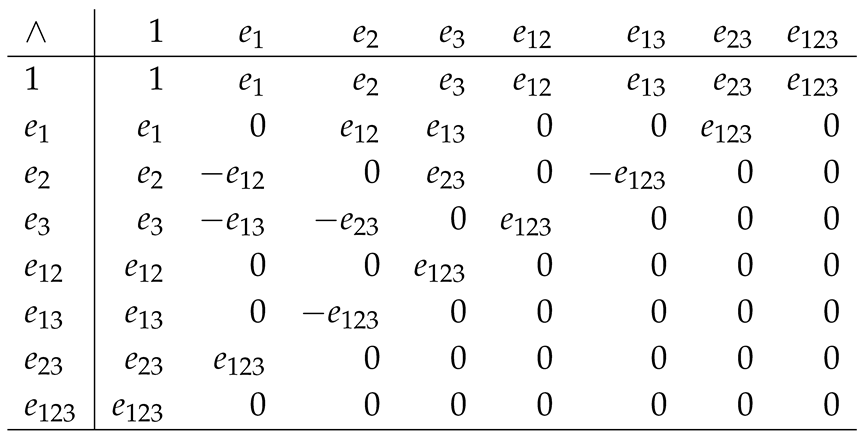
Appendix A.6. Noether Symmetries of a Second-Order Lagrangian
Consider the action
A Noether current comes from the first-order variation of boundary terms of the action,
while the complete variation of the system is
so that both terms vanish on shell.
To obtain the rotational symmetry, consider the infinitesimal virtual rotation of magnitude specified by the constant bi-vector . The resulting variations are
For example, is developed to first order as
In the same way
Therefore, the Noether current becomes
Therefore, the bi-vector
is conserved on shell, where the geometric derivative is also suitably extended as .
To obtain the translational symmetry, consider an infinitesimal virtual translation in direction v and of magnitude . Then the variations are
Then we have
and in the same way the vector
is conserved on shell.
To obtain the Hamiltonian consider an infinitesimal virtual stretch . Then the variations are
Then
Differentiate P:
However,
Therefore,
On shell the second term vanishes so that
Therefore, the scalar Hamiltonian
is conserved along the lines of Ostrogradsky theory [23].
References
- Hasimoto, H. A soliton on a vortex filament. J. Fluid Mech. 1972, 51, 477–485. [Google Scholar] [CrossRef]
- Tsuru, H. Equilibrium Shapes and Vibrations of Thin Elastic Rod. J. Phys. Soc. Jpn. 1987, 56, 2309–2324. [Google Scholar] [CrossRef]
- Fukumoto, Y. Analogy between a vortex-jet filament and the Kirchhoff elastic rod. Fluid Dyn. Res. 2007, 39, 511–520. [Google Scholar] [CrossRef]
- Matsutani, S. Euler’s Elastica and Beyond. J. Geom. Symmetry Phys. 2010, 17, 45–86. [Google Scholar] [CrossRef]
- Saalschütz, L. Der Belastete Stab Unter Einwirkung Einer Seitlichen Kraft; B. G. Teubner: Leipzig, Germany, 1880. [Google Scholar]
- Greenhill, A.G. The Applications of Elliptic Functions; Macmillan & Co: London, UK, 1892. [Google Scholar]
- Levien, R. The Elastica: A Mathematical History. Technical Report UCB/EECS-2008-103. 2008. Available online: https://www2.eecs.berkeley.edu/Pubs/TechRpts/2008/EECS-2008-103.pdf (accessed on 2 August 2025).
- Love, A. A Treatise on the Mathematicaltheory of Elasticity; Cambridge University Press: Cambridge, UK, 1906. [Google Scholar]
- Greco, L.; Cuomo, M. Consistent tangent operator for an exact Kirchhoff rod model. Contin. Mech. Thermodyn. 2014, 27, 861–877. [Google Scholar] [CrossRef]
- Langer, J.; Singer, D.A. Lagrangian Aspects of the Kirchhoff Elastic Rod. SIAM Rev. 1996, 38, 605–618. [Google Scholar] [CrossRef]
- Hestenes, D.; Sobczyk, G. Clifford Algebra to Geometric Calculus; Springer: Dordrecht, The Netherlands, 1984. [Google Scholar] [CrossRef]
- Doran, C.; Lasenby, A. Geometric Algebra for Physicists; Cambridge University Press: Cambridge, UK, 2003; p. 592. [Google Scholar]
- MacDonald, A. Linear and Geometric Algebra; CreateSpace Independent Publishing Platform: Scotts Valley, CA, USA, 2010; p. 223. [Google Scholar]
- Prodanov, D.; Toth, V.T. Sparse Representations of Clifford and Tensor Algebras in Maxima. Adv. Appl. Clifford Algebr. 2016, 27, 661–683. [Google Scholar] [CrossRef][Green Version]
- Hestenes, D. Space-Time Algebra, 2nd ed.; Birkhäuser: Basel, Switzerland, 2015; ISBN 978-3-319-18413-5. [Google Scholar]
- Dorst, L. The Inner Products of Geometric Algebra. In Applications of Geometric Algebra in Computer Science and Engineering; Dorst, L., Doran, C., Lasenby, J., Eds.; Birkhäuser Boston: Boston, MA, USA, 2002; pp. 35–46. [Google Scholar] [CrossRef]
- Prodanov, D. Clifford: A Lightweight Package for Performing Geometric and Clifford Algebra Calculations. 2016. Available online: https://zenodo.org/records/8205828 (accessed on 2 August 2025).
- Chappell, J.M.; Iqbal, A.; Gunn, L.J.; Abbott, D. Functions of Multivector Variables. PLoS ONE 2015, 10, e0116943. [Google Scholar] [CrossRef] [PubMed]
- MacDonald, A. Vector and Geometric Calculus; CreateSpace: Scotts Valley, CA, USA, 2012. [Google Scholar]
- Hestenes, D. The Shape of Differential Geometry in Geometric Calculus. In Guide to Geometric Algebra in Practice; Springer: London, UK, 2011; pp. 393–410. [Google Scholar] [CrossRef]
- Bishop, R.L. There is More than One Way to Frame a Curve. Am. Math. Mon. 1975, 82, 246–251. [Google Scholar] [CrossRef]
- Singer, D.A.; Garay, O.J.; García-Río, E.; Vázquez-Lorenzo, R. Lectures on Elastic Curves and Rods. Aip Conf. Proc. 2008, 1002, 3–32. [Google Scholar] [CrossRef]
- Rashid, M.S.; Khalil, S.S. Hamiltonian Description of Higher Order Lagrangians. Int. J. Mod. Phys. A 1996, 11, 4551–4559. [Google Scholar] [CrossRef]
- Mandal, B.P.; Pandey, V.K.; Thibes, R. BFV quantization and BRST symmetries of the gauge invariant fourth-order Pais-Uhlenbeck oscillator. Nucl. Phys. B 2022, 982, 115905. [Google Scholar] [CrossRef]
- Langer, J.; Singer, D.A. Knotted Elastic Curves in R 3. J. Lond. Math. Soc. 1984, 30, 512–520. [Google Scholar] [CrossRef]
- Langer, J.; Singer, D.A. The total squared curvature of closed curves. J. Differ. Geom. 1984, 20, 1–22. [Google Scholar] [CrossRef]
- Djondjorov, P.; Hadzhilazova, M.; Mladenov, I.M. Explicit Parameterization of Euler’s Elastica. In Proceedings of the 9th International Conference on Geometry, Integrability and Quantization, Varna, Bulgaria, 8–13 June 2007; Institute of Biophysics and Biomedical Engineerin: Sofia, Bulgaria, 2008; pp. 175–186. [Google Scholar] [CrossRef]
- Shi, Y.; Hearst, J.E. The Kirchhoff elastic rod, the nonlinear Schrödinger equation, and DNA supercoiling. J. Chem. Phys. 1994, 101, 5186–5200. [Google Scholar] [CrossRef]
- Ameline, O.; Haliyo, S.; Huang, X.; Cognet, J.A.H. Classifications of ideal 3D elastica shapes at equilibrium. J. Math. Phys. 2017, 58, 062902. [Google Scholar] [CrossRef]
- Liu, L.W.; Hong, H.K. Clifford algebra valued boundary integral equations for three-dimensional elasticity. Appl. Math. Model. 2018, 54, 246–267. [Google Scholar] [CrossRef]
- Grigoriev, Y.M.; Yakovlev, A.M. Transversally isotropic elastic material applicable for permafrost rocks: A case study. Arct. Subarct. Nat. Resour. 2023, 28, 337–345. [Google Scholar] [CrossRef]
- Klimek, M.; Kurz, S.; Schöps, S.; Weiland, T. Discretization of Maxwell’s Equations for Non-inertial Observers Using Space-Time Algebra. Adv. Appl. Clifford Algebr. 2018, 28, 22. [Google Scholar] [CrossRef]
Disclaimer/Publisher’s Note: The statements, opinions and data contained in all publications are solely those of the individual author(s) and contributor(s) and not of MDPI and/or the editor(s). MDPI and/or the editor(s) disclaim responsibility for any injury to people or property resulting from any ideas, methods, instructions or products referred to in the content. |
© 2025 by the author. Licensee MDPI, Basel, Switzerland. This article is an open access article distributed under the terms and conditions of the Creative Commons Attribution (CC BY) license (https://creativecommons.org/licenses/by/4.0/).